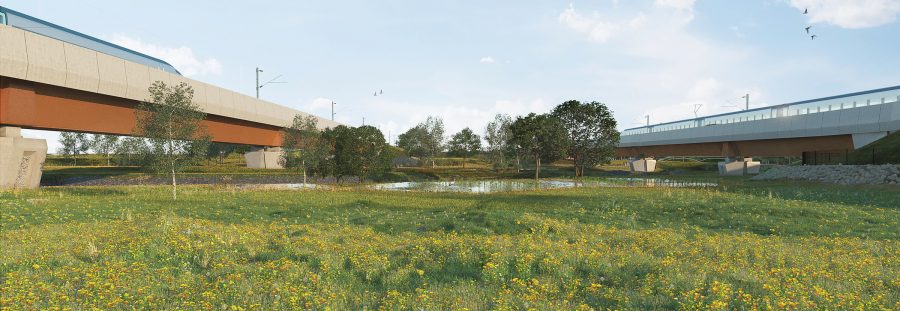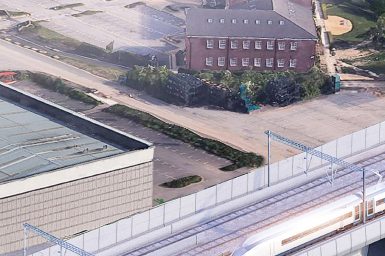
River Cole Viaducts and Chattle Hill Structure
The line of the new HS2 railway travels through North Warwickshire, crossing the M6, M6 slip road to the A446 Lichfield Road and M6/M42 junction on box structures and viaducts known as the River Cole Viaducts and Chattle Hill Structure. The route crosses over the River Cole on two parallel viaducts, while the Chattle Hill Structure is located in the north east corner of the Delta Junction, taking the HS2 line over Lichfield Road.

Slide 1 of 4: Artist's impression of the view of the River Cole Viaducts, from the footpath towards the River Cole (1).

Slide 2 of 4: Artist's impression of the view of the River Cole Viaducts.

Slide 3 of 4: Artist's impression of the view of the River Cole Viaducts, from the footpath towards the River Cole (2).

Slide 4 of 4: Map showing the Delta Junction.
Viaducts construction
The section of the HS2 route where the River Cole Viaducts and the Chattle Hill Structure are situated is referred to as the Delta Junction – a triangular section of line where the HS2 route curves west towards Birmingham and runs north towards Crewe and beyond.
It is located within the Cole Valley Landscape Character Area where the River Cole West Viaduct and River Cole East Viaduct curve away from the northbound route, bringing HS2 passengers into the heart of Birmingham at the city’s Curzon Street Station.
Two HS2 viaducts will be constructed near Coleshill, and the landscape around them will create new public spaces with footpaths and cycleways allowing people to enjoy and better understand their local heritage. The area has a rich history, including a medieval deer park, the Tudor Coleshill Manor and the expansive Elizabethan garden that HS2 archaeologists recently uncovered.
Further north, the Chattle Hill Structure will be constructed from reinforced concrete and is designed for an operational life of 120 years. Most of the railway in this area will be raised above existing ground level, in order to span across existing roads, railways and rivers.
It will allow the HS2 line to cross over the A446 Lichfield Road, letting vehicles, cyclists and pedestrians pass underneath. A continuous noise barrier will be provided along the east of the track to reduce noise levels for local residents. As part of the works, the Structure will facilitate upgrading of the A446 to a dual carriageway, in line with Warwickshire County Council’s future aspirations.
Viaducts design
The River Cole Viaducts and Chattle Hill Structure are known as Key Design Elements (KDE), which means it is important for us to involve and provide feedback to the local community while we design these elements.
The design vision is for the Delta Junction to be a catalyst to integrate HS2 into the landscape and also to use HS2 to integrate the site into the wider area. This will be achieved by creating a harmonic relationship with the railway, the site and wider landscape through the use of connectivity, habitat creation and biodiversity, landscape integration and flood mitigation.
The plans are designed to ensure the least possible disruption to local communities and HS2 is in discussions with the local highways authority regarding the implementation of traffic management associated with the construction of the Chattle Hill Structure.
The aim is to minimise the impact of construction and to integrate the scheme into the surrounding landscape and the design has considered the need to conserve, enhance, restore and transform the area where the River Cole Viaducts are located.
Designs for the the viaducts include reducing the height of the western viaduct from 10m to 4m, which results in a 36% reduction in materials being used and a 26% reduction in the viaduct’s carbon footprint. Changing the girder from concrete to steel also brings environmental benefits, including reducing the use of materials and the construction time, with 97% of the steel coming from recycled sources.
Design engagement
Landscape and the environment
Extensive new landscape and wildlife areas inspired by local heritage will be created around the viaducts, while new footpaths and cycleways will promote active travel and enable people to explore the rich history of the area. Wetlands, ponds and habitats will also provide homes for fish, amphibians, dragonflies, otters, great crested newts, reptiles and badgers, increasing the local biodiversity.
The land beside the River Cole has been identified as a heritage hotspot, as it shows a rich history from pre-Roman times up to the middle of the last century. Two of the main heritage assets of the area, Coleshill Manor parkland and the Elizabethan Manor of Coleshill Hall, have been used to influence the design of the landscape in this area.
For the area closest to the River Cole Viaducts a parkland landscape has been designed so it flows down to the realigned river. Further south, a grid of tree planting has been included, which harks back to a similar feature found in the Elizabethan era.
At the Chattle Hill Structure, there are plans for a ‘blossom walk’ to link to a new community orchard and allotment areas, along with the planting of fruit trees and herbs for foraging.
Explore the In Your Area Map

Archaeology
The map displays information about our archaeological sites along the route.

Green Corridor
The map displays information about our environmental sites along the route.

HS2 funded projects
The map displays information about our funded community and business projects along the route.
Keeping you informed about our works

Stay informed about the works
Find information about HS2 works and activities taking place in your area.

Managing impacts of construction
Find out information about how we manage construction impacts.

Construction look-ahead
Read our three-month lookahead for associated work in Warwickshire.

Find out what HS2 means for Warwickshire
This section provides you with information about HS2 works and developments in your area.
Find out more